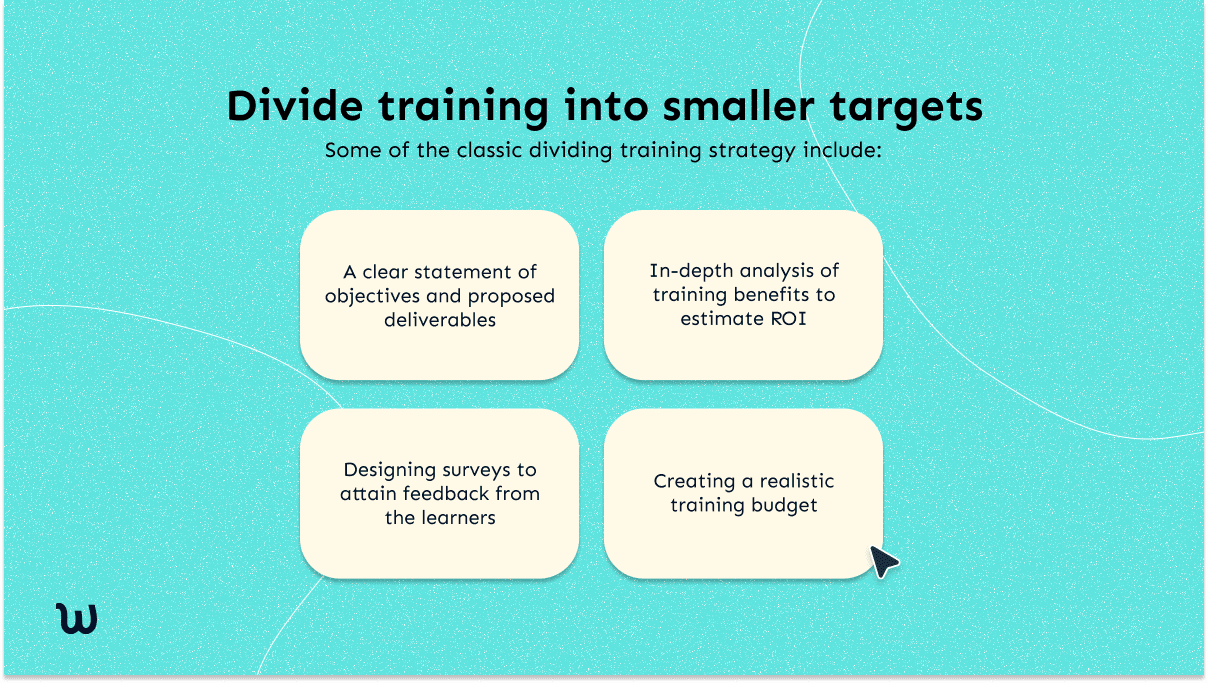An employee training implementation plan is a critical part of every successful organization, specifically during the onboarding of new employees. If proper training is absent, the efforts may go wasted. In contrast, practical training strategies can put workers on a path to success.
You can commit several mistakes as an employer while preparing training initiatives for employees, such as using outdated and boring training methods. Training implementation often fails to meet participants' expectations and organizational objectives when planned poorly.

In today's remote working environment, it is necessary to have ongoing training that can also be delivered online. The employee training initiative program should be built by following a step-by-step, systematic process. Here are the ten ways to deploy thriving employee training initiatives.
💡 Tip: To hire the best employee training software, just click here. All your training, onboarding, documentation and best practices in one place. A single source of truth for your team – we’ve got it all covered.
Establish Goals aligned with Employee Needs and Company Requirements
Training is necessary for your team, but it is also essential for your company's growth. The more dedicated, engaged, and skilled your employees are, the more efficient your business is. Having exceptional subscription services, piles of books, and free courses is useless if your business goals are not aligned with employee and company requirements.
When you keep the company's goal and vision in your mind when developing employee training initiatives, this will help you to:
- Provide a strategic approach on ways to invest in your training initiatives
- Get an accurate idea of what you can achieve after investing your money in training programs.
- Deliver relevant training opportunities to your employees. This affects their job performance positively.
Take Employees on Board and take Recommendations.
You have to provide your employees with an atmosphere where their opinions are heard. Create a great company culture by listening to your employee's ideas and conflicts.
A study shows that 65% of employees do not engage as they feel they cannot approach their employer with any question.
Also, 75% of employees would like to stay in a company that understands and solves their concerns.
All your workers need balanced and regular feedback, especially when implementing training initiatives. Feedback is necessary, so your employees can align their performance with the organizational culture. You should address areas that need improvement and praise the behavior that matches your company's values.

Build Systematically Crafted Training Curriculum
One of the critical aspects of impactful training and development strategies is creating an effective curriculum. It should be such that it drives employees together to work towards the set goal.
Additionally, it should outline those necessary initiatives to enhance employee engagement levels at every training step. Aim to establish a culture of learning that emphasizes self-development and overall team improvement.
Use a tailored approach to training and development by crafting a curriculum that caters to all employees' needs. Likewise, recognize cultural differences and create a shared language.
Match Training with Customer Requirements
It is essential to sync employee training with your customer needs. Whether they are your external customers or internal customers, the employee training initiatives should ultimately lead to customer satisfaction.
Offering positive customer experiences enhances customer retention rates and increases the customer base. Therefore, avoid focusing only on work procedures and processes.
Work on training employees to better understand your products and services. Make them confident that they can learn to interact and deal with customer-facing situations effectively and comfortably.
Divide Training into Smaller Chunks
Once you have drafted the employee training plan, divide it into smaller achievable targets. This helps analyze whether you are accomplishing the desired results at each stage of the training.
It also helps in detecting flaws and areas for improvement in your training implementation plan.
Some of the distinctive classic elements dividing training strategy include:
- A clear statement of objectives and proposed deliverables
- In-depth analysis of training benefits to estimate ROI
- Designing surveys to attain feedback from the learners
- Creating a realistic training budget including all vital expenses

Set Timeframe For Each Section Of The Training
Setting a timeline is essential when taking training initiatives for employees. Before starting the training, assess how much time is needed to complete each program section.
Your training content and mode of delivery also determine how much time you require to complete the training. Remember to make training methods exciting and engaging and devise a realistic timeframe for completion.
With a proper schedule, you allow your workforce to plan for attending training. You increase employee motivation and get better results when each training goal is accomplished within a given timeframe.
Invest in Better Instructors
Ensure the instructors you hired for training are experts. Usually, on-the-job training provides excellent results when you have proper tools and professional instructors providing the training.
However, it is also vital not to bombard your employees with all the information on the first day. But provide just-in-time training when they are ready to use the information.
Implement Standard Training Methods
Mainly, employees consider training unnecessary or uninteresting. Even if they participate in the training program, they lose interest. The primary reason behind such ineffective training methods is their failure to comply with the learner's needs.
This highlights the significance of implementing training methods that deliver the information in the format that suits learners the best. Some of the standard training methods include:
- E-Learning
- Instructor-led training
- Hands-on training
- Lectures
- Coaching or mentoring
- Role-playing
- Group activities and discussions
- Studying real-life scenarios and Case studies
You can choose one or more training methods according to the employees' learning needs and training goals.
Add Flexibility Into Training
From the mid-20s to late 30s, your company may have employees of different ages and interests. Some employees may prefer training sessions on their mobile phones, while others want to have a classroom set up. It is essential to add different learning styles in your training initiatives to have something that appeals to every team member.
According to research conducted by McKinley, 55% of employees want to have a flexible working environment as a part of their package.
Use Standard Training Tools
It is undoubtedly a great challenge to train both existing and new employees, specifically in a quickly changing business atmosphere. The next step is to choose training tools to ensure that training information is easily accessible to learners. Selecting innovative tools is a financial decision as your company must make a wise investment in its training resources. In this way, you keep the training costs under control.
Waybook is a wise investment that can help your workforce and business to thrive tremendously. Its unique features allow you to customize training programs as per the special needs of the learners.
Want to get more insights on the future of Training & Management? Check out our related resources:
- Employee Training and Development Methods with Examples
- How To Train Employees on New Software
- Employee Cross Training Plan Template








